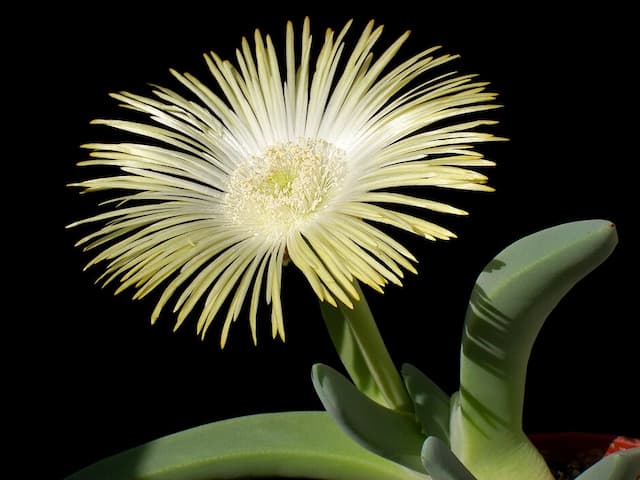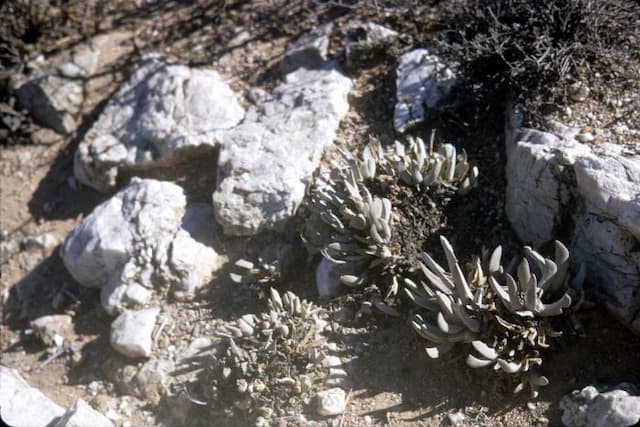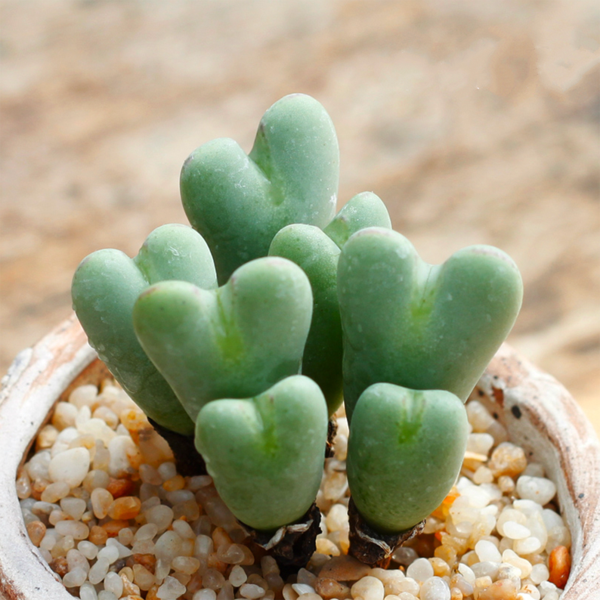Living Stones Conophytum obcordellum

ABOUT
Conophytum obcordellum, commonly referred to as the living pebble, closely resembles a collection of small, smooth pebbles or stones that have been gathered together. This plant's unique characteristic lies in its fleshy, succulent leaves that are tightly fused together at their base, forming a shape akin to a pair of split rocks or pebbles. These paired leaves vary in color from shades of green to greyish or even purplish tinges, often with patterns, dots, or lines enhancing their stone-like appearance. The surface of the leaves might exhibit a slightly translucent quality, sometimes giving a windowed effect that allows light into the interior tissues of the leaf. These peculiar leaf windows may help with photosynthesis, particularly under conditions of intense sunlight. The living pebble has a distinctive growth habit with new leaves emerging from a fissure between the older leaf-pair each season, resulting in the older pair of leaves eventually drying and peeling away as the new set expands to take their place. This natural cycle contributes to the tidy, compact presentation of the plant. During blooming periods, the plant produces small, daisy-like flowers that emerge from the central cleft where the leaves meet. These flowers can be quite colorful - typically in shades of yellow or orange, contrasting pleasantly with the stone-like base upon which they perch. The blooms generally appear in fall or early winter and may attract pollinators, though the living pebble is also capable of self-pollination. Overall, the appearance of Conophytum obcordellum is evocative of a miniature cluster of stones or pebbles, with occasional bright floral accents that add to its charm and appeal.
About this plant
 Names
NamesFamily
Aizoaceae
Synonyms
Dumpling Plant, Button Plant, Cone Plant, Living Pebbles
Common names
Conophytum obcordellum
 Toxicity
ToxicityTo humans
Conophytum obcordellum, commonly known as the Dumpling Plant, is not known to be toxic to humans. As a succulent, it's generally not considered edible, and there is limited information on the consequences of ingesting this plant. However, it is always wise to avoid eating ornamental plants as they are not intended for human consumption, and unknown allergic reactions or gastrointestinal disturbances could occur.
To pets
The Dumpling Plant is not known to be toxic to pets such as dogs and cats. If a pet ingests a small amount of this plant, it is unlikely to cause harm or display symptoms of poisoning. Still, it's best to prevent pets from eating plants, since they may cause gastrointestinal upset due to the fibrous plant material that can be difficult to digest.
 Characteristics
CharacteristicsLife cycle
Perennials
Foliage type
Evergreen
Color of leaves
Green
Flower color
Varies
Height
0.1 feet [3 cm]
Spread
0.2 feet [6 cm]
Plant type
Succulent
Hardiness zones
10
Native area
South Africa
Benefits
 General Benefits
General Benefits- Decorative appeal: Conophytum obcordellum, commonly known as Dumpling Plant, has a unique and attractive appearance, making it a popular choice for succulent collectors and as a decorative houseplant.
- Low maintenance: It requires minimal care, which is ideal for those who do not have the time or are not experienced in plant care.
- Drought tolerance: Adapted to arid conditions, the Dumpling Plant can survive long periods without water, making it an excellent plant for xeriscaping and water-wise gardens.
- Small footprint: Its compact size makes it suitable for growing in small spaces, including windowsills, terrariums, and miniature gardens.
- Propagation ease: It can be easily propagated from offsets or leaf cuttings, allowing growers to expand their collection or share with others.
- Year-round interest: Conophytum obcordellum exhibits changes in color and form with the seasons, providing year-round visual interest.
- Non-toxic: Being non-toxic, it is safe to keep around pets and children without the worry of toxicity issues.
 Medical Properties
Medical PropertiesThis plant is not used for medical purposes.
 Air-purifying Qualities
Air-purifying QualitiesThis plant is not specifically known for air purifying qualities.
 Other Uses
Other Uses- Conophytum obcordellum, commonly known as living stones, can be used in miniature gardening to create a realistic desert landscape due to their unique stone-like appearance.
- Landscape architects can incorporate living stones into xeriscaping designs, which is a landscaping approach that reduces or eliminates the need for supplemental water from irrigation.
- Educational use in biology or botany courses to teach students about the survival strategies of succulents, including CAM photosynthesis and water storage adaptability.
- Decorative displays in art installations that feature natural elements, because living stones can provide an interesting visual texture and context about plant mimicry.
- Use in terrariums or as novel centerpieces for events that require long-lasting and low-maintenance plants.
- Gifts for enthusiasts of rare or unusual plants due to the distinctive and curious nature of the living stones.
- Living stones can serve as a subject for macro photography because of their intricate patterns and shapes.
- Research topics in the field of plant adaptation and evolution studies due to their specialized survival techniques.
- Hobbyists in rock gardening use them to add authenticity and botanical interest without high maintenance needs.
- They can be used in workshops and DIY kits for creating fairy gardens or small-scale fantasy landscapes.
Interesting Facts
 Feng Shui
Feng ShuiThe plant Conophytum obcordellum, commonly known as the "living stone," is not typically used in Feng Shui practice.
 Zodiac Sign Compitability
Zodiac Sign CompitabilityThe living stone is not used in astrology practice.
 Plant Symbolism
Plant Symbolism- Adaptability – Conophytum obcordellum, commonly known as the 'Dumpling Plant,' has adapted to survive in harsh, arid environments, symbolizing the ability to thrive in difficult conditions.
- Resilience – The Dumpling Plant can go long periods without water, symbolizing endurance and the strength to recover from challenges.
- Unique Beauty – With its unusual, almost cute appearance, the Dumpling Plant symbolizes the beauty found in uniqueness and the value of standing out from the crowd.
- Persistence – Their persistent nature in the wild symbolizes the importance of persistence in life to overcome obstacles.
- Simplicity – The minimalist form of the plant represents simplicity and the idea that there is elegance and power in a simple existence.
 Water
WaterConophytum obcordellum, commonly known as "Dumpling Plant," should be watered sparingly, as they are susceptible to overwatering. The Dumpling Plant prefers a 'soak and dry' method, meaning the soil should be thoroughly drenched and then allowed to dry out completely before the next watering. During its active growth period, typically in the cooler months from fall to spring, you may water the plant every 2-3 weeks, applying about 2-4 ounces of water depending on the size of the pot. In the summer dormant period, reduce watering to once a month or less, paying close attention to the moisture level of the soil.
 Light
LightThe Dumpling Plant thrives in bright, indirect light, making it ideal for a spot that receives partial sunlight, such as a south-facing window with some shading or an east-facing window. Direct sunlight may scorch the delicate leaves, so take care to provide filtered light especially during the hottest parts of the day.
 Temperature
TemperatureThe Dumpling Plant prefers stable temperatures between 50°F and 70°F but can withstand short dips as low as 40°F, and high temperatures up to 80°F, making it suitable for indoor cultivation where these conditions can be maintained. It's not frost-hardy, so if grown outside, ensure it is protected or moved indoors during cold weather.
 Pruning
PruningPruning the Dumpling Plant is minimal and generally involves removal of dead or shriveled foliage. Gently prune any dead leaves during the plant's growing season to promote healthy growth and avoid any fungal infections. This task is infrequent, based on visual inspection and necessity rather than a set schedule, and the best time for pruning is in the fall when the plant begins its active growing phase.
 Cleaning
CleaningAs needed
 Soil
SoilThe Button Plant, Conophytum obcordellum, thrives best in a well-draining soil mix, typically composed of a combination of coarse sand, perlite, and a small amount of organic material. A recommended recipe is 50% coarse sand, 40% perlite, and 10% compost. Aim for a slightly acidic to neutral soil pH of around 6.0 to 7.0 for optimal growth.
 Repotting
RepottingThe Button Plant should be repotted every two to three years or when the plant outgrows its container. It's best to repot Conophytum obcordellum during its growing season, which is fall to spring, to reduce stress and ensure root health.
 Humidity & Misting
Humidity & MistingConophytum obcordellum, commonly known as the Button Plant, prefers low to moderate humidity levels consistent with its natural arid habitat. Ideal humidity should range from 40-50%, avoiding overly humid conditions that can encourage rot.
 Suitable locations
Suitable locationsIndoor
Grow Button Plant indoors with bright, indirect light and minimal water.
Outdoor
Place Button Plant outside in bright shade and protect from heavy rain.
Hardiness zone
10-11 USDA
 Life cycle
Life cycleConophytum obcordellum, commonly known as Dumpling Plant, begins its life cycle when seeds germinate in the fall, taking advantage of milder temperatures and moisture. The seedlings develop into a pair of succulent leaves that are fused at the base, characteristic of the genus. During the winter growing season, the Dumpling Plant slowly matures, photosynthesizing and storing water within its thick leaves. As spring approaches, the plant enters dormancy to survive the harsh summer conditions, with old leaves drying out and new leaves forming inside the old pair. After summer, the plant re-emerges from dormancy, often producing vibrant flowers that, once pollinated, will produce seeds to start the next generation. The cycle continues as long as the plant experiences the correct seasonal variations and receives proper care.
 Propogation
PropogationPropogation time
Late summer-autumn
The most popular method of propagation for Conophytum obcordellum, commonly known as the living stones, involves seed sowing. The best time for sowing is in the fall, just before their natural growing season begins. Fresh seeds germinate more readily, so using recent harvests can enhance success rates. Sow the tiny seeds thinly onto a well-draining soil mixture, ideally one that is sandy with some organic matter. Then, cover the seeds with a very fine layer of sand or grit and gently water them. Keep the soil moist but not waterlogged, and at a consistent temperature of around 65 to 75 degrees Fahrenheit (18 to 24 degrees Celsius). Seedlings usually appear within a few weeks, and at this stage, it's critical to ensure they receive bright, indirect light and controlled watering to mirror their naturally arid habitat.
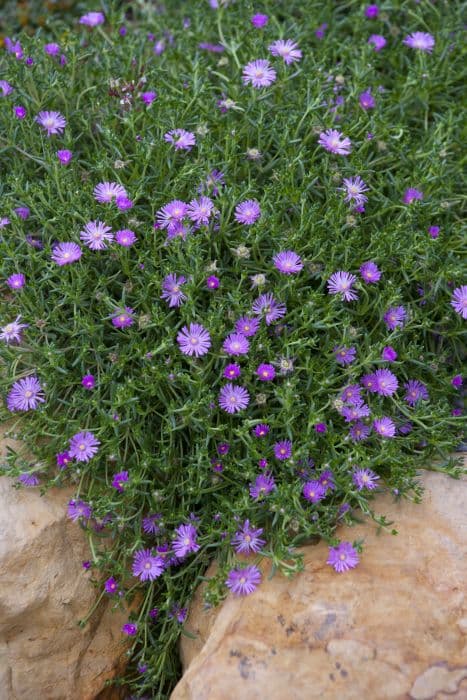
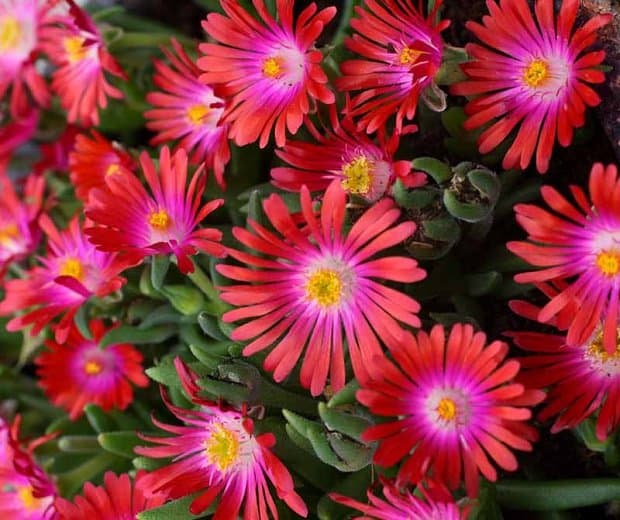
![Ice plant [Fire Spinner]](/_next/image?url=https%3A%2F%2Fplants-admin.emdemapps.com%2Fimages%2Fplants%2F%2Fimages%2F604b54d98722a.png&w=640&q=75)



